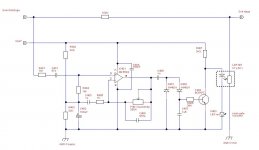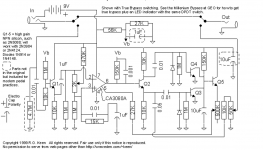I'm getting much closer to finding my personal "ideal" tube guitar/bass preamp, except I'd love to have control of compression/expansion dynamics without reliance on power supply sag or the distortion that accompanies running the tubes outside their linear response range.
I thoroughly understand the various uses of compression for guitar and bass.
But fooling around using the expander from my hi-fi on clean percussive guitar is also interesting.
I guess I should look at what Trace Elliot did for the compressor in their v-6 and v-8 bass amps, or I think the current Fender tube bass amp also has a tube compressor. So I might just steal their designs.
Are there opto-isolators that respond fast enough? Maybe with an LED and some fast detector? That could sure make the task simple and easy for me to understand. A VCA stage with a pot for how much signal can bypass the opto-isolator. To make a control signal I could run the main signal thru an appropriate low-pass filter so it follows the volume envelope. If I put that control signal on one side of a series resistor, I could switch the "light" to be across that envelope signal or it's opposite, so I could have compression or expansion. Then I could mix an op-amp oscillator signal into the control signal to add tremolo.
As a separate subject, at a different point in the circuit (after the first stage) I'd probably also like a downward expander with a sharp adjustable knee and adjustable rate, to work as a noise gate. Most noise gates in a "stomp box" mess up the lovely match between my guitar and first tube stage. How hard is it to include some kind of tube noise gate in a tube guitar preamp?
I thoroughly understand the various uses of compression for guitar and bass.
But fooling around using the expander from my hi-fi on clean percussive guitar is also interesting.
I guess I should look at what Trace Elliot did for the compressor in their v-6 and v-8 bass amps, or I think the current Fender tube bass amp also has a tube compressor. So I might just steal their designs.
Are there opto-isolators that respond fast enough? Maybe with an LED and some fast detector? That could sure make the task simple and easy for me to understand. A VCA stage with a pot for how much signal can bypass the opto-isolator. To make a control signal I could run the main signal thru an appropriate low-pass filter so it follows the volume envelope. If I put that control signal on one side of a series resistor, I could switch the "light" to be across that envelope signal or it's opposite, so I could have compression or expansion. Then I could mix an op-amp oscillator signal into the control signal to add tremolo.
As a separate subject, at a different point in the circuit (after the first stage) I'd probably also like a downward expander with a sharp adjustable knee and adjustable rate, to work as a noise gate. Most noise gates in a "stomp box" mess up the lovely match between my guitar and first tube stage. How hard is it to include some kind of tube noise gate in a tube guitar preamp?
Last edited:
There are some opto's that are fast enough for guitar. It needs to be the LED based opto (most common) and you want to stay in the middle of its range. There is a recovery time associated with full on LED.
I have decided to go with another approach. My first experiments are all solid state, but a tube implementation is coming.....sometime.
A compressor is made of two components, a Variable Gain Amplifier, and a level detector (RMS "meter"). There are two possible implementations, both common, with different results. Many compressors do some of both.
he Sta-Level type, puts the level detector after the VGA, and controls the VGA to attempt to keep the output level nearly constant. This type will do nothing on the low level input signals, and start removing gain once the input reaches a certain threshold. The gain reduction increases at a non linear rate until full reduction is in effect, then a limiter takes over. This was invented for broadcast transmitters to meet FCC regulations, but has found many audio applications.
The "linear" compressor puts the level detector on the input and removes gain in a db for db relationship. This was common in the early days of LP recording to fit dynamic music into the 45 db range of an LP record.
A modern compressor uses both of these techniques, several types of limiters, peak squashers, and multiple time constants to "make the music louder".
The same elements used in a compressor can be used to make a dynamic range expander. About 30 years ago Signetics designed a chip to do both, the NE570. It went extinct about 25 years ago, but has been brought back from the dead by On Semiconductor, and is still stocked at Digikey. Read the datasheet. It explains a lot of this.
I chose to go a different route. The DIY modular synthesizer forums have all sorts of schematics for Voltage Controlled Amplifiers (VGA) and Envelope Followers (level detector). With these blocks (and a few others) you can make all sorts of cool guitar effects. I plan to stuff all of this inside the guitar once my new lab is operational (about 6 months).
http://www.onsemi.com/pub/Collateral/NE570-D.PDF
I have decided to go with another approach. My first experiments are all solid state, but a tube implementation is coming.....sometime.
A compressor is made of two components, a Variable Gain Amplifier, and a level detector (RMS "meter"). There are two possible implementations, both common, with different results. Many compressors do some of both.
he Sta-Level type, puts the level detector after the VGA, and controls the VGA to attempt to keep the output level nearly constant. This type will do nothing on the low level input signals, and start removing gain once the input reaches a certain threshold. The gain reduction increases at a non linear rate until full reduction is in effect, then a limiter takes over. This was invented for broadcast transmitters to meet FCC regulations, but has found many audio applications.
The "linear" compressor puts the level detector on the input and removes gain in a db for db relationship. This was common in the early days of LP recording to fit dynamic music into the 45 db range of an LP record.
A modern compressor uses both of these techniques, several types of limiters, peak squashers, and multiple time constants to "make the music louder".
The same elements used in a compressor can be used to make a dynamic range expander. About 30 years ago Signetics designed a chip to do both, the NE570. It went extinct about 25 years ago, but has been brought back from the dead by On Semiconductor, and is still stocked at Digikey. Read the datasheet. It explains a lot of this.
I chose to go a different route. The DIY modular synthesizer forums have all sorts of schematics for Voltage Controlled Amplifiers (VGA) and Envelope Followers (level detector). With these blocks (and a few others) you can make all sorts of cool guitar effects. I plan to stuff all of this inside the guitar once my new lab is operational (about 6 months).
http://www.onsemi.com/pub/Collateral/NE570-D.PDF
I see the practicality of being modular. I'd love to massage the same envelope follower signal (detecting volume at a very early uncompressed stage) to control a voltage-controlled filter (placed at a very late stage after distortion and all other aspects of tone are established).
Maybe what I really need is send/receive loop patch jacks between each stage. Or some truly modular packaging.
Maybe what I really need is send/receive loop patch jacks between each stage. Or some truly modular packaging.
I've had an ongoing modular synth build, for 19.5 years now.. Just recently got a guitar.
A cpl weeks ago I built a little amp 'module' so I can plug my guitar into it, and get it up to the 10v synth signal level. The guitar interface module I made contains an envelope follower as well, to generate CV's from the guitar signal amplitude.
It's really really cool. Endless possibilities.
I highly recommend making a completely modular/patchable effects system. Put the compressor/expander in it, put a filter in it.. And if you want any suggestions of other really fun synth-related modules that work well w/ guitar, I'd love to talk about it.
A cpl weeks ago I built a little amp 'module' so I can plug my guitar into it, and get it up to the 10v synth signal level. The guitar interface module I made contains an envelope follower as well, to generate CV's from the guitar signal amplitude.
It's really really cool. Endless possibilities.
I highly recommend making a completely modular/patchable effects system. Put the compressor/expander in it, put a filter in it.. And if you want any suggestions of other really fun synth-related modules that work well w/ guitar, I'd love to talk about it.
I'm starting to think I'd like a separate preamp power supply with a regulated filtered output, and a regulated DC filament supply. Then I'd make a bunch of adjustable gain and tone stack stages, each on a separate small chassis. And just line 'em up.
A useful link:
All sorts of Tube and SS compressors, equalizers, and other audio "gizmos".
Classic Schematics
Cheers,
Ian
All sorts of Tube and SS compressors, equalizers, and other audio "gizmos".
Classic Schematics
Cheers,
Ian
Just reminding you that you need the detector to be a bit slow or the onset of compression to be gradual for a bass signal. If the squashing happens too fast (short attack time) it makes a low frequency signal--like the 41hZ low E on a 4-string bass--have a really bizarre shape and distorted sound.
So I am suggesting that for bass an opto might be a good way to go. For guitar, this is less of a problem since the lowest note is an octave higher...
So I am suggesting that for bass an opto might be a good way to go. For guitar, this is less of a problem since the lowest note is an octave higher...
Just to share my experience on that area: here is my compression and noise gate schematics. Both work with LDR.
For compression control I use a voltage controlled resistor: the lower the signal the higher the resistance. From signal flow point of view its passive and easy to be implemented. In my 400W bassamp I have placed it before the mastervolume.
The noise gate is basically the same philosophy, except that the control is the opposite way. It is placed after the first stage in my guitar amp. There is a nice small hysterese in the switching mechanism. When switching off caused by a small signal below thresholdthe signal becomes even a little bit smaller because the 100K switched to ground vie LDR is now an additional load to the input.
For compression control I use a voltage controlled resistor: the lower the signal the higher the resistance. From signal flow point of view its passive and easy to be implemented. In my 400W bassamp I have placed it before the mastervolume.
The noise gate is basically the same philosophy, except that the control is the opposite way. It is placed after the first stage in my guitar amp. There is a nice small hysterese in the switching mechanism. When switching off caused by a small signal below thresholdthe signal becomes even a little bit smaller because the 100K switched to ground vie LDR is now an additional load to the input.
Attachments
- Status
- Not open for further replies.
- Home
- Live Sound
- Instruments and Amps
- compression/expansion control in guitar preamp


